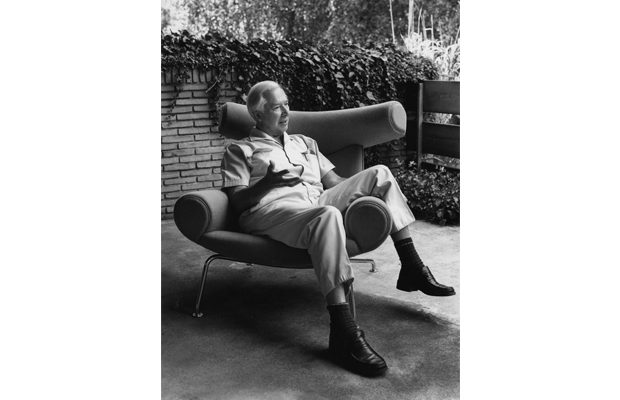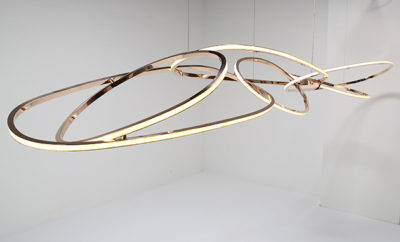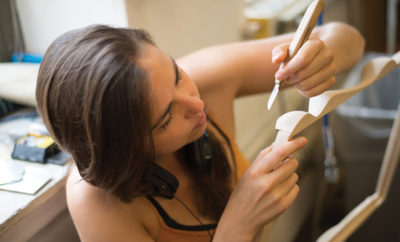 Hans J. Wegner (1914– 2007) in his Ox chair (designed 1960), his favorite easy chair at home.
Hans J. Wegner (1914– 2007) in his Ox chair (designed 1960), his favorite easy chair at home.
Design
Danish Master Hans Wegner
CELEBRATING THE CENTENNIAL OF A DESIGN ICON
IN HIS PURSUIT TO CREATE A PERFECT CHAIR, Danish furniture master Hans J. Wegner designed hundreds of them, often experimenting and working out details with scale models. The results led to innovations and precedents that largely defined hand- crafted, studio produced pieces from the modern era. Recognition of the furniture’s long-standing appeal coincides this year with the centennial of Wegner’s birth.
Knud Erik Hansen, CEO of Carl Hansen and Son, longtime producers of Wegner furniture, explains contemporary appreciation for the master: “He highly valued simplicity and comfort and he is recognized for providing minimalism with an organic and natural softness. His designs are characterized by functionality, aesthetics, and high quality—often in an exquisitely simple design that is easy to relate to and without unnecessary details. The fact that Wegner was a cabinetmaker first and a designer second makes him a unique furniture designer—a master of detail who flawlessly merges craftsmanship with exquisite design.”

Wegner-designed Papa Bear (or Teddy Bear) chair and ottoman (1950) made by A. P. Stolen. Courtesy of Wright.
Among the events to mark the centennial of Wegner’s birth is a large retrospective at the Designmuseum Danmark in Copenhagen, Hans J. Wegner—Just One Good Chair (on view through December 7), where visitors are encouraged to try out dozens of newly produced Wegner-designed pieces. The Kunstmuseet i Tønder, in Wegner’s hometown of Tønder near the German border, is simultaneously exhibiting Hans J. Wegner: A Nordic Design Icon from Tønder (through November 2) alongside its permanent Wegner installation of some forty chairs that the designer considered among his best works and donated to the museum in 1995. Both museums have published accompanying catalogues. Danish filmmaker Pi Michael is completing a documentary about Wegner as part of the centennial. For collectors, perhaps the most accessible and gratifying event is Bruun Rasmussen’s forthcoming auction in Copenhagen in December, “Centenary of the King of Chairs.” This special Wegner sale of rare and familiar pieces will include works from the Designmuseum exhibition.

Interior of Wegner’s home. Courtesy of Designmuseum Danmark.

Installation shot of the Hans J. Wegner—Just One Good Chair exhibition at the Designmuseum Danmark.
Today Marianne Wegner Sørensen, Wegner’s daughter who is also a furniture designer, leads her father’s studio near Copenhagen. While she concentrates on new work, Anders Brun oversees daily operations and works with the “seven and a half manufacturers” currently producing Wegner’s furniture. He playfully explains that the “half” is the Vitra Design Museum, which makes miniature versions of Wegner’s 1949 Wishbone chair and his 1963 three-legged Shell chair. Brun says that about 170 different full-sized chairs, tables, and other pieces are currently in production from Carl Hansen and Son, Erik Jørgensen, Fredericia Furniture, Fritz Hansen, Getama, PP Møbler, and Pandul. This year’s reintroductions include the first (1948) Shell chair and bench, made by Getama exclusively for London-based retailer John Lewis, which is celebrating its 150th anniversary. The Wegner Studio also occasionally introduces Wegner designs that were never manufactured or only briefly available during the master’s lifetime. For example, as part of the centennial observance, Carl Hansen and Son has issued the CH88 chair designed in 1955, which had previously existed only in prototype.
The Hansen firm has been producing Wegner’s furniture since 1949, when it first issued the Wishbone chair, a perennial best seller. They also manufacture about thirty of his other designs, and were the first to make such popular models as the Elbow, three-legged Shell, Wing, and Oculus chairs, in addition to a few limited edition pieces. To mark the fiftieth anniversary of the three-legged Shell chair, the company produced a numbered edition of 150 upholstered in a special red Niger goat hide. This year, for the Wegner centennial, Hansen is offering a limited series of chairs upholstered in Maharam fabrics designed by Paul Smith.

Peacock chair, designed 1947, made by Johannes Hansen, c. 1960.

The CH07 Shell Chair has long been viewed as one of Hans J. Wegner’s strongest designs. It first saw the light of day in 1963, but took 35 years before it enjoyed it’s popular breakthrough and received numerous design awards. The CH24 Wishbone Chair, designed in 1950, was one of the first four pieces that Hans J. Wegner designed for Carl Hansen & Son. It has been in continuous production for over 60 years. Photos courtesy of Carl Hansen & Son.
PP Møbler, another longtime producer of Wegner furniture, today makes a different set of Wegner’s classic, best-selling chairs—the Teddy Bear (or Papa Bear), Peacock, Swivel, Round, and Circle models—along with dozens of his other designs.
While the availability of authorized, newer production pieces is growing, the market for Wegner’s vintage furniture is also strong, with examples often selling above estimate at auction. Last May a vintage 1954 desk and organizer offered by LA Modern Auctions sold for $50,000, five times its high estimate. Missi Bullock, showroom manager at Wyeth, a mid- century modern retailer in New York, points out, “The original is ideal for many reasons, including an increas- ing market value—but buying vintage can be challenging. For one thing it is difficult to find large quantities, and it is also costly, since vintage pieces usually require some level of restoration.” Wyeth, which is PP Møbler’s partner, is considered to have the largest collection of new and vintage Wegner furniture and is known for its in-house craftsmen who specialize in the restoration of Wegner designs. The choice of new versus vintage is not a question of aesthetics or aura, since the high levels of craftsmanship and material specified by Wegner are virtually unchanged. In several instances the only difference between new and vintage are subtle variations in wood finishes.

Hans J. Wegner (1914 – 2007) in his studio studying one of the many models he constructed throughout his lifetime. Courtesy of Carl Hansen & Son.
Bullock thinks international demand for Wegner’s classic designs will continue to outpace supply, and adds, “There are markets that have yet to discover Wegner. His designs are now featured prominently in Japanese interiors, and I can only imagine what will happen when the rest of Asia becomes aware of Wegner.”












